- This birthday happened sooner than I expected. At some point, you are just living your life, day to day, month to month, doing your thing, and then the year 40 rolls around. Oh, is it here? Already? Well, come on inside, I just put the kettle on.
- I entered my 30s having no real clue what I was doing with my life and it shows. My 20s, on the other hand, had me working at one job for four and a half years and living in one house for over five years. When that stability ended, I got a little unfocused.
- It has been almost ten years since I was last to Scotland.
- Injuring my right knee and the long road to recovery really screwed with my head. There are certain events where the only way to think of them is as there being a time before and a time after. One little slip completely changed the direction of my life. I still think about what my life would have been without it.
- And yet, that injury led to a new appreciation for how much I love being physically strong and out of doors. So, um, that’s good?
- Thru-hiking the Pacific Crest Trail and moving back to Portland immediately after really screwed with my head. Like the knee injury, I now think of my life as a time before the PCT and a time after the PCT. I doubt there has been a single day that I have not daydreamed about strapping on a pack and going for another long walk.
- A voice in my head continually wonders why, with the plethora of trees in my neighborhood, I need to wait until I get home to pee.
- Despite all of my skiing and mountaineering photos, I am actually not that fond of being cold.
- I swing between acceptance and dorky rage about losing hair on top of my head. I mean, come on! It was so lush! And my forehead is just getting HUGE! ::sigh::
- At last check, I had four grey hairs in my beard. That does not seem to really bother me at all.
- The amount I have saved for retirement is no where near enough, which is a bit embarrassing considering my income potential.
- Thanks to Amelia’s cats, especially Diego, I think I am ok with cats now. But in my heart, I still want a dog.
- Despite all of my donations, regular messages to my representatives, public comments to government agencies, and a general attempt to stay informed and engaged…I am not sure anything I did last year made a damn difference.
- Fresh bread, made by your own hand, is pretty great.
- My health is good. No disease or illness exists and my activity level remains exceptionally high. Even with all of the injuries and damage to pretty much, well, everything, my physical problems are manageable. I suspect another knee intervention is drawing near though.
- Professionally, more and more I am convinced that half of what most developers and engineers spend their time on is a complete waste. Poor management, bad direction, and incompetence are rampant in my industry.
- Where the hell is The Doors of Stone, Rothfuss? I’m not getting any younger here!!
- I trim my nasal hairs now. That’s a thing.
- My unibrow, after a very productive couple decades, has really chilled out though. The Lord giveth and the Lord taketh away.
- When I first read Stalin’s Barber, I did not really understand the point of a Turkish singeing. That is no longer the case and I promise this is the last mention of hair in this entry.
- After a year and a half of regular bouldering, I am concerned that I am always going to feel like a shit climber with no appreciable skill. Probably would be helpful to stop watching videos on Instagram of climbers who have been climbing for literal decades.
- Still not King.
- I have rewatched The Force Awakens, Last Jedi, Solo, and Rogue One in the last year. While I enjoyed them a smidgen more the second time around, Empire Strikes Back still blows them all out of the water.
- Before I turned 30, a number of people kept on telling me to watch out because my metabolism would start to slow down. Well, losers, here I am at 40 and I still spend more than $400 a month on food. I’M STILL WAITING!!
- This is the age at which I became a CTO of a technology company. Ha ha, that kid, he had no idea what he was in for.
- We really need to set up a pull-up bar and/or hangboard at home. Our current house is really quite old and has not been the best maintained, so I am rather uneasy about mounting anything as I am not sure it would bear my weight.
- This is half my age plus seven years. Um, yeah, no way, no how.
- The Cascadia subduction zone unnerves me. At any moment, a colossal earthquake could occur and completely devastate the region. It is a major contribution to why I have never bought a home here. It may be 50 years before it happens but the uncertainty does not sit well with me.
- Not sure if it is age or all the time I have spent outdoors this past decade, but I find the city extremely loud and smelly. Painfully so. On days when I am tired or have not eaten recently, the amount of sensational intrusion can make me rather anxious.
- Thirty is the sum of the first four squares, which makes it a square pyramidal number. Make one out of zinc and then you can be a true nerd.
- I am still a little weirded out that I bought a brand new car. I researched options, compared prices, negotiated, and even got a car loan. All the things! And now I have a shiny car where everything works properly and there are heated seats. Every so often I still get a whiff of new car smell. Weird.
- The age when I first started drinking coffee. Made it all the way through Reed College and two startups before Pre-Med in my 30s required this level of mental booster.
- I still listen to Disney musical numbers on an almost daily basis. In fact, I am listening to one right now while I write this. No apologies.
- Bicycling may kill me. Thousands of miles of biking a year and with the growing population in Portland there is significantly more car traffic, so I feel less safe on the road. You have to be a very defensive biker as you never know when one careless driver on their phone may turn right in front of you. Without exaggeration, it happens on nearly every single bike ride. It seems like it is simply a matter of time before Tina or I are in an accident. It weighs on my mind.
- Posted on Twitter: “The person you were at 22 does not get to decide who you have to be for the rest of your life.” This is solid advice. Things change, people change, and you can change the entire direction of your life if you want to. It’s yours.
- God does not exist. I believe that. I have faced my own mortality often enough that it is not some loosely held belief tossed at the first scent of death. If anyone, post-Paul, says otherwise, tell them to politely fuck off.
- Bataffleck is the best Batman.
- Some people say they would never go back to when they were 18, 21, 25, 30, whatever. Me? Totally would. I am willing to give it another shot. And then another, and then another. I mean, think of all the things I could try with my life. Eesh, it’s like people are satisfied with a single data point. Where’s your sense of scientific curiosity?
- When it comes down to it, you really need so little to survive. Food and water. Shelter. Most days I really believe that and cannot believe the level of luxury I live in. Other days, I think to myself, “Come on, just buy a second pair of pants, Paul.”
- My biggest concern for the future is what mankind is doing to this planet and all of the life on it. The current books I am reading are Poached by Rachel Nuwer and The Uninhabitable Earth by David Wallace-Wells. The words “crisis” and “catastrophe” are an understatement. We are destroying our home and the majority of humans are not paying attention.
Picnic Training - Week 8
March 3, 2019 to March 9, 2019
Sunday - 3.75 hours bouldering at NE Circuit
Monday - 9 miles of bike commuting. 1.5 mile pool swim
Tuesday - Bike ride (21 miles, 1700 ft)
Wednesday - Rest Day
Thursday - 5 miles of bike commuting. 1.5 mile pool swim
Friday - 2.5 hours bouldering at NE Circuit
Saturday - 4 hour bike ride (49 miles, 4500 ft)
The weather was finally good, so we got in a longer weekend bike ride. Went out past Sauvie Island and then did a few hills before heading towards Council Crest. While we were on Newberry Rd, we paused and got to see the construction finally happening to repair the road. Looking good but the road is completely closed until they finish. Took Wednesday off as I was feeling a bit tired and sore all over, so I wanted a bit of a rest.
Picnic Training - Week 7
February 24, 2019 to March 2, 2019
Sunday - 3.5 hours bouldering at NE Circuit
Monday - 1.75 mile pool swim
Tuesday - Cold and windy bike ride (21 miles, 2000 ft)
Wednesday - 16 laps on Mt. Tabor stairs (4 miles, 2400 ft)
Thursday - 1.25 hours bouldering at NE Circuit
Friday - Backcountry Ski on Mount St. Helens (12.6 miles, 6300 ft)
Saturday - 1 mile pool swim and 9 miles of biking around town
The training keeps on building. We had no rest days this week, instead we decided to have two easy days surrounding our St. Helens climb, which we knew was going to be a fairly long day. Even with no rest days, our bodies seemed to handle the training load well. Short 15-20 minute naps a couple times a week in the late afternoon are becoming a regular habit though.
Picnic Training - Week 6
February 17, 2019 to February 23, 2019
Sunday - Downhill skiing at Mt. Bachelor.
Monday - Rest day!
Tuesday - 1.5 hours on bike trainer.
Wednesday - 1 mile swim.
Thursday - Council Crest bike ride (20 miles, 1600 ft). Red Cross Blood Donation.
Friday - Rest day. Biked 4 miles to tea.
Saturday - Mt. Hood Backcountry Ski from Gov't Camp to Silcox Hut (8 miles, 3300 ft)
After an exhausting weekend of climbing, backcountry skiing, and downhill skiing while still being sick, this week necessitated me not pushing it too hard. My body was feeling a bit worn out and needed an easier workout schedule. Also, my regular blood donation was scheduled weeks ago for Thursday, which hard experience has shown requires a full day off afterwards or else I feel poorly for much longer. Backcountry skiing on Saturday felt relatively fine though.
Picnic Training - Week 5
February 10, 2019 to February 16, 2019
Sunday - 3 hours of bouldering at NE Circuit.
Monday - Rest day!
Tuesday - 1 hour of swimming (2700 yd = 1.5 miles). 1 hour on bike trainer.
Wednesday - 1 hour on bike trainer.
Thursday - SICK DAY!
Friday - 2.5 hours of bouldering at NE Circuit.
Saturday - Two laps of backcountry skiing on Tumalo Mountain (3000 ft, 6 miles)
This week was rudely disrupted by a nasty cold that knocked me down pretty hard on Wednesday night. Shortly after getting off the bike trainer, my body went from mildly unhappy to completely miserable. I was still fairly sick during Saturday's laps on Tumalo Mountain, but the fresh powder was so amazing that it was completely worth it, despite the occasional hacking cough.
Picnic Training - Week 4
February 3, 2019 to February 9, 2019
Sunday - Full day of downhill skiing at Snoqualmie Pass
Monday - Rest day! 2.5 miles of walking.
Tuesday - 1 hour of swimming (2650 yd = 1.5 miles).
Wednesday - Bike 4 miles to Mt. Tabor, run 14 laps on stairs, bike 3 miles back from Mt. Tabor.
Thursday - 47 minutes of swimming (2000 yd). 2.5 hours of bouldering at NE Circuit.
Friday - 1.5 hour bike ride to Council Crest (20 mi, 1700 ft)
Saturday - 1.5 hours on bike trainer, 45 minute core/strength workout
This week was a bit problematic thanks to weather. A winter storm made the roads icy on Tuesday, so a short afternoon bike ride got canceled. A long bike scheduled for Saturday was foiled by another few inches of snow and freezing rain making the roads treacherous. Oh well.
Picnic Training - Week 3
January 27, 2019 to February 2, 2019
Sunday - 3.5 hours of bouldering at NE Circuit.
Monday - Rest day! 4 miles of walking.
Tuesday - 52 minutes of swimming (2200 yd). 1 hour bike ride, 17 mi, 942 ft.
Wednesday - Bike 4 miles to Mt. Tabor, run 11 laps on stairs, bike 3 miles back from Mt. Tabor.
Thursday - 1 hour on bike trainer. 3.75 hours of bouldering at NE Circuit.
Friday - 52 minutes of swimming (2,050 yd)
Saturday - 4 hours bouldering at Stone Gardens.
Little light on biking this week because of a weekend trip to Seattle. Lots and lots of climbing. My body still feels it.
Rye hast thou forsaken me?
If you follow me on Instagram, you may have noticed a number of stories and posts about baking bread these past few months. Way back in September, Tina checked out Flour Water Salt Yeast from the Multnomah County library with the intention of learning more about bread making. We had recently finished binge watching an entire season of the Great British Bake Off, so thoughts of warm, homemade baked goods was on her mind.
However, the arrival of the book coincided perfectly with my schedule opening up thanks to my contract job ending abruptly. Nothing like having an extra 35 hours of free time in your week to make you consider exploring a new hobby.
At first, I merely flipped through the book and enjoyed daydreaming about baking real bread. Not a bread where you merely mixed ingredients together in a certain order, but a bread where you crafted it with your own two hands from the simplest building blocks using basic principles. A purer, more intellectual way of creating food, where you understood so much more. The Romantic Notion of the Artisanal Baker delusion, as I like to think of it now.
My initial foray was tame. At the back of the book is an entire chapter on homemade pizza. Now, you may not be aware of this, but I once had the metabolism of a young male in his prime. Pizza is one of my very favorite foods. Bread, tomato sauce, cheeses, veggies. As they say in the Instagram biz, "#omnomnomnom"
So, the very first recipe in the book is "The Saturday White Bread," which is a perfect foundation for making both pizza and bread. It is a rather simple recipe too. Combine the four ingredients of flour, water, salt, and yeast in the correct proportions. Wait about five hours for the yeast to work their fermentation magic, and then build your pizza.
And, holy hand grenade, that pizza was scrumptious! Later that week, at a Great British Baking Show party, I used the remaining dough to make an olive oil and dill focaccia with sea salt sprinkled on top. Hot damn, another tasty success! Buoyed by two successes, we renewed the book and I decided to try my hand at the bread itself.
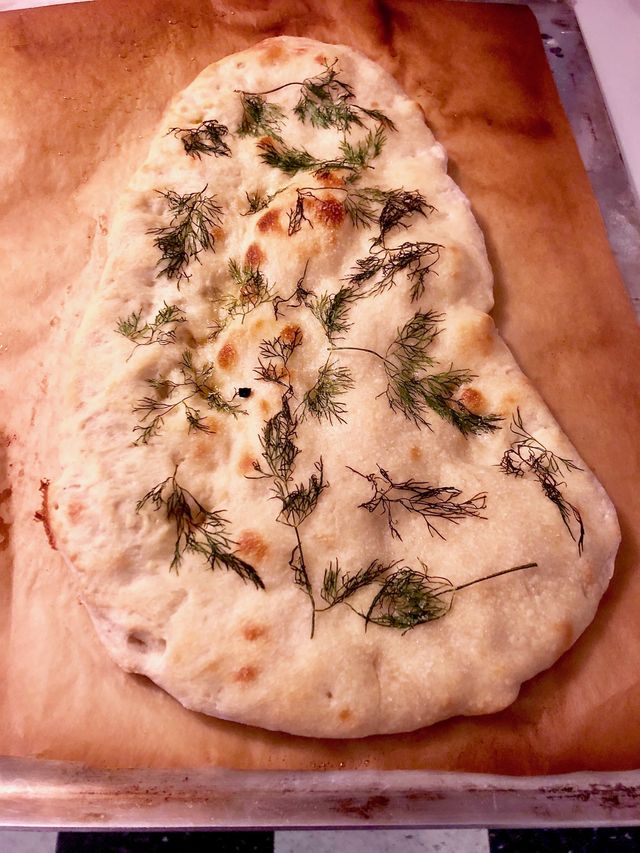
It's funny to me now how unsophisticated my equipment and skills were at this point months ago. I was using a brewing thermometer to measure my water temperature. This thermometer was both slow to change and had a narrow temperature range, so my water temps were more guesses than precise measurements. Our old measuring scale had an LCD screen that only partially showed its first digit and also had a habit of randomly bouncing 3-5 grams at a time. My proofing baskets were initially metal bowls with flour tossed in.
And yet, it all worked out fine. My first real loaf turned out great and was my first introduction to "shaping" and "proofing." Two terms that I vaguely recall emanating from Amelia's mouth at one time or another, but I had never really had conceptualized what they entailed.
Next came the Overnight White Bread. Waiting an entire night for your dough to ferment! How novel! Waking up to the lovely smell of percolating dough just waiting to be shaped and baked is quite a treat.
Ah, but then I tried to make a 75% Whole Wheat Bread—with an old, opened bag of wheat flour. It was no good. The loaves got tossed out. They only smelled slightly off but tasted horrible. Into the compost bin they went. Later that day, I hiked over to the store to buy a fresh bag of whole wheat flour. With this new flour, I moved on and tried a different recipe, The Overnight 40% Whole Wheat Bread. Hot damn this is a delicious bread. Just a bit hearty with a faint nutty taste. Perfect with a solid helping of raspberry jam.
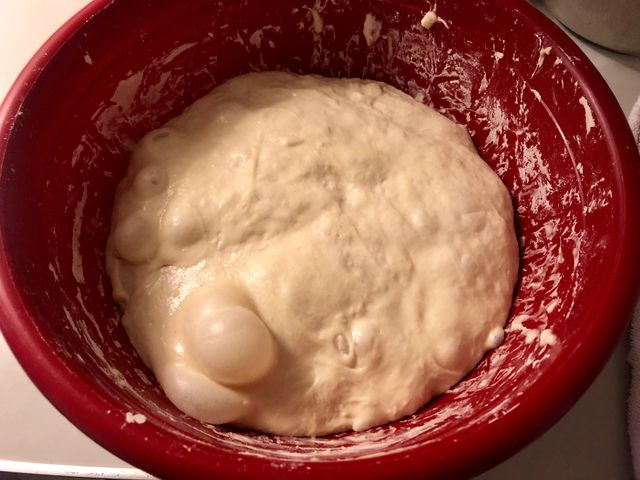
Pre-Ferments
Next came the recipes using the pre-ferments biga and poolish. These pre-ferments are simply a portion of the yeast, flour, and water combined the night beforehand and allowed to ferment for 12 to 14 hours before the final mixing. The biga is the stiffer of the two pre-ferments while the poolish creates a rather light bubbly mixture. The next morning you combine these pre-ferments with the remaining ingredients and proceed normally. The bulk fermentations are shorter thanks to the preferments doing more of the work beforehand, but you still shape, proof, and bake as with the previous recipes.
There were two recipes for each type of pre-ferment with one being all white flour and another switching in a portion of whole wheat (the poolish added in wheat germ and wheat bran too). The poolish seems to create a lighter, buttery flavor and the biga is more earthy in tone. Both are delicious, but we found the poolish so delightful I made it twice.
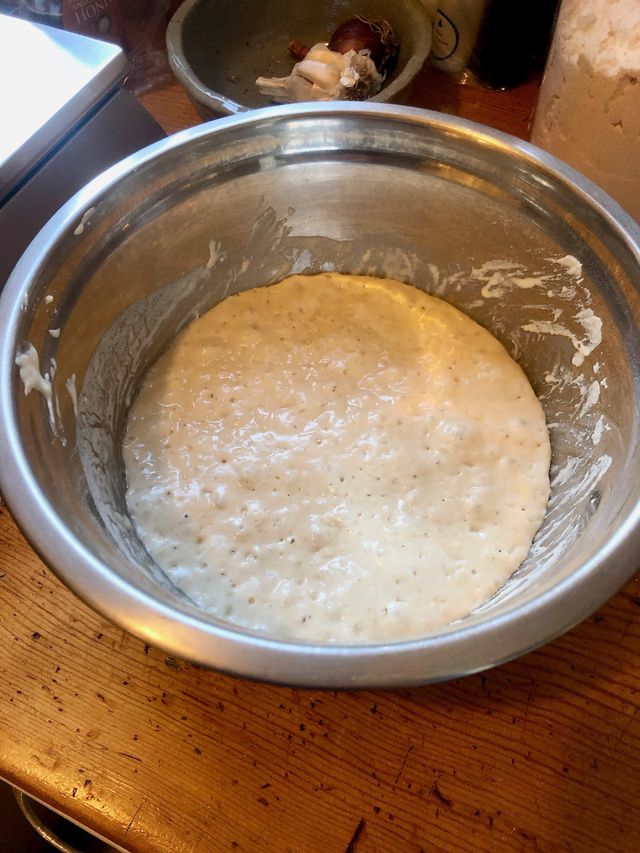
Sourdough Starter
Finally, I reached the sourdough section of the book. First step is to establish your own levain, which is a culture of yeast and bacteria used for all of your future sourdough bread making. According to the book's instructions, it should take about 5 days to create your own starter from only flour and water. After the starter is established, you keep it going with daily feedings of flour and water on a regular schedule. Almost sounds like having a pet, doesn't it?
I had some trepidation about this process, so much in fact that I waited over two weeks to start. Ken firehoses you with information about levains: their history, possible ingredients, culture development, and feeding schedules. It all seemed a bit intimidating and hard to grasp, especially once you start doing additional research online. Did not help that a friend related how he was never unable to get his own sourdough starter started (say that three times fast). Our house is also pretty cool in winter, which is the opposite of a warm, cozy bakery.
Anyhoo. After acquiring a new thermometer, mixing containers, and a functional scale, I started the process and honestly it was not so bad.
You are essentially combining flour and water in a tub and waiting for the naturally occurring yeast within the flour to multiply and form a thriving colony. Each day you throw away 3/4s of the existing starter and add new flour and water as new fuel. It multiplies, grows, and you feed it again the next day. Repeat for a few days and soon you should have a nice, gassy sourdough starter with a distinct smell. That's it!
The most important trick I learned is to have a dedicated plastic mixing bucket (with lid) for the starter and to keep it in a warm area, which for us is on top of our kitchen's heater vent with a thin towel underneath. This keeps the starter away from direct heat but allows it to be near its ideal temp of 75°-90° Fahrenheit.
Once the culture gets going, you will get a sense of what it prefers as far as flour/water ratios and water temperature. For instance, every morning I keep 50g of my starter, add 100g of white flour, 25g of wheat flour, and 125g of 95° Fahrenheit water. This maintains my starter and keeps it nice and happy for the next 24 hours. It really is a wonder. With those same ratios, I can put the starter in the fridge for 3-5 days without touching it. When I want to restart it, I just pull it out in the morning and refresh it normally. By the next day it is all happy and ready to make bread again.
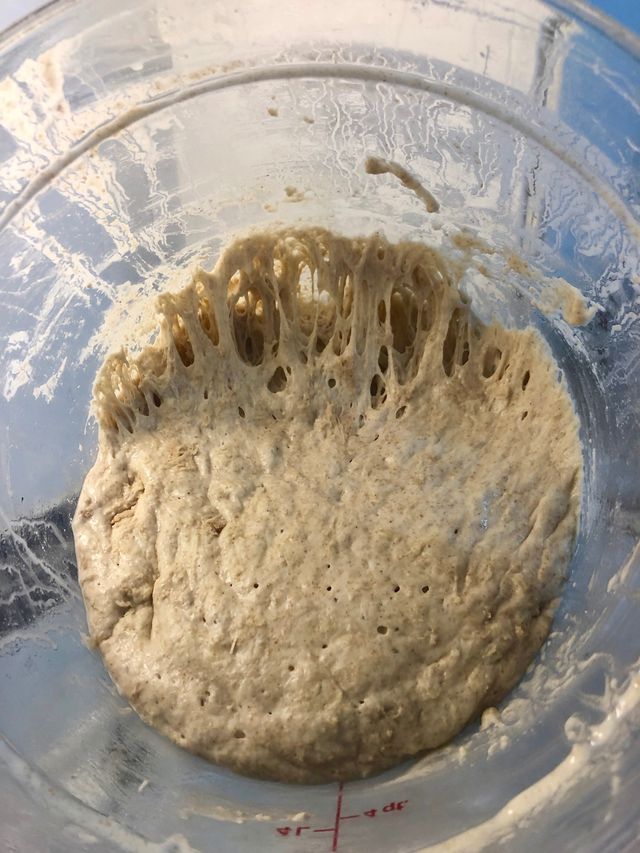
Sourdough Breads
The sourdough breads have been interesting so far. I have made Pain de campagne, 75% Whole Wheat Levain, Bran-Encrusted Levain, and Walnut Levain. These are all hybrid breads that use a levain starter but also include a bit of baker's yeast in the final mix. Wheat is still the flour of choice.
Each recipe has you refreshing the levain in the morning, doing the mix mid-afternoon, and shaping the bread around 8pm at night. The bread then proofs overnight in the refrigerator and you bake it first thing in the morning. This schedule works out rather well as I can get up the next morning, bake the bread, and then head off to a coffee shop until I return home for lunch, where fresh bread awaits.
As an experiment, I made two loaves of the 75% Whole Wheat Levain and proofed one that night on the counter for an hour and then baked it at 9:30pm. Turned out perfectly lovely, so one does not necessarily have to proof in the fridge with these recipes.
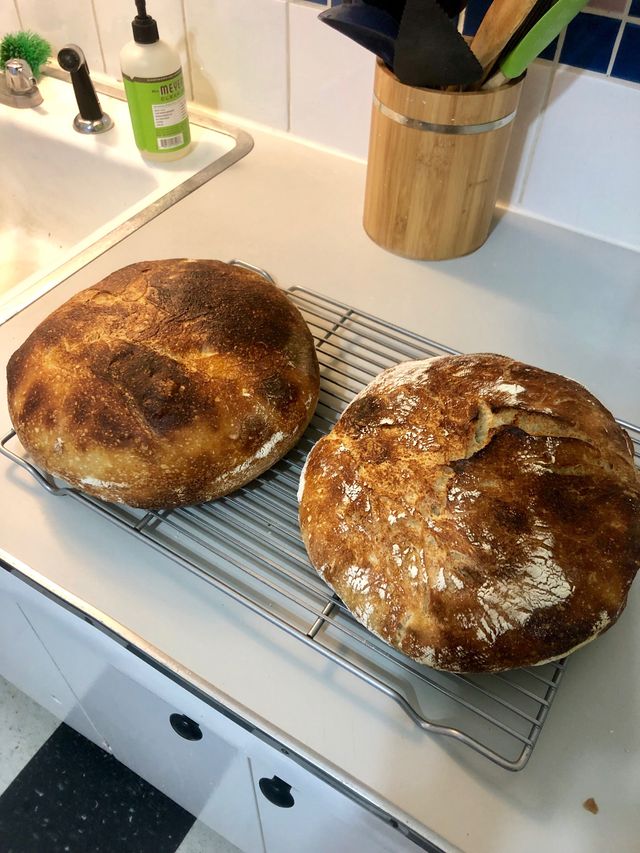
The Walnut Levain is pretty damn fantastic; I see why people rave about it online. The tannins seep out of the roasted walnuts giving it a beautiful color, and the taste when it is toasted and given a nice layer of butter + honey on top is sublime. Seriously, this is the kind of bread people will gossip about.
Oh, by the way, with the levain breads, I do the same thing I do with the sourdough starter and leave it on top of a heating vent with a towel underneath. This ensures it gets the right amount of warmth for the five or so hours of bulk fermentation.

Sourdough Bread with Rye
This weekend I tried my first blended bread using a combination of wheat and rye flour. Ken touches briefly on the differences you can expect. The rye flour has less gluten, the dough will be stickier, and you can expect a smaller crumb. All of these turned out to be true. I could not find white rye flour in the store, so I used dark rye flour and kept the percentage at 15%.
I am quite fond of this bread. Many of my wheat breads had fantastically large gas bubbles, which made huge holes in my slices. With pockets that large, honey or jam had a bad habit of dribbling out. The smaller, softer crumb of this bread makes it ideal for sandwiches. I am curious whether putting tomato sauce and cheese on top and then toasting it in the toaster oven will create a nice slice of bread-pizza for lunch.
I consulted with my favorite professional baker about rye and she mentioned that while rye has less gluten, it also has "some very interesting enzymatic chemistry." This led me down a rabbit hole of research yesterday morning about rye, its chemical differences, and a plethora of different types of rye breads.
For instance, some rye bread recipes include ground spices such as fennel, coriander, aniseed, cardamom, or citrus peel. ::strokes chin:: Doesn't that sound delicious?!
Also. There is a Swedish crispbread made primarily of rye called knäckebröd, which brings to mind lembas from Lord of the Rings. Apparently, traditionally a hole is made in the middle so it can be stored on a long wooden poles for months at a time. Cool! Might need to try that one out this year.
<insert inspiring platitude here>
As a funemployed gentleman, this book came at just the right time for me to pick it up and explore bread making. There is an overwhelming amount of knowledge online about it too. You can easily lose an hour watching YouTube videos of people, both professionals and amateurs, explaining how they make their bread. And almost everyone does it differently!
At the end of the day, bread making it is not that hard. People have been making it for thousands of years without scales, thermometers, or the perfect knowledge of the gluten content in their flours. You can definitely screw it up, but most of the time you are going to create a perfectly delicious bread that makes your house smell amazing. Just remember to share it. Oh, and buy the really good butter to smear on top...
Picnic Training - Week 2
January 20, 2019 to January 26, 2019
Sunday - 3 hours of bouldering at NE Circuit.
Monday - Rest day! 2.5 miles of walking.
Tuesday - 40 minutes of swimming (1400 yards), 90 minute massage.
Wednesday - Bike 3.5 miles to Mt. Tabor, run eight laps on stairs, bike home.
Thursday - 1:15 on bike trainer, 3 hours of bouldering at NE Circuit.
Friday - 42 minutes of swimming (2000 yards)
Saturday - 3 hours biking in West Hills (35 miles, 4200 ft elevation gain)
Training for a Mt. Hood Picnic
Now that I have written up my ideas for A Mount Hood Picnic and posted them publicly, there is more pressure to sit down and work out some manner of training plan.
Strict training plans have never been my forte. When I was doing ultramarathon training back in 2017, I had a rough sketch of the mileage I should be hitting every week and also the length of my longest run for that week. My philosophy is that you should have weekly and monthly goals, but the actual day-to-day plan should be in flux based on soreness, energy-level, weather, and schedule. That flexibility is key to success for me. I know that if I am required to do a certain activity, I will chafe under the strict regiment. My personality simply does not like taking orders, even from myself.
When training for a backcountry triathlon, especially in winter and spring, this flexibility is even more helpful. There are days in Portland when it is 34 degrees and raining, which is simply not going to support a successful long bike ride. Or, we will have a harder than expected bouldering session and need longer than 12 hours to recover before doing our second swim session of the week. Or, friends want to go up to the mountain for a day of backcountry skiing, so we modify the week's plan to support that addition.
Wait! Did he just say bouldering and backcountry skiing? Those are not triathlon sports! What's going on here?!
Our plan includes doing activities besides swimming, biking, and running. We want to keep on bouldering twice a week and skiing a few times a month. Those are activities we enjoy and allow us to spend time with friends. As intense as a picnic will be, we do not want to make the next four months of exercise solely about training for it. That does not seem fun at all. I mean, I have a huge stick up my ass, but not about this.1
Instead, we have a white board with the specific picnic training activities we wish to accomplish each week and where we think they fit into our schedule. This schedule includes rest and easy days, as well as things like core workouts, stretching, and a monthly massage. Even on rest days, I am typically trying to walk a few miles to help loosen up my body and encourage recovery. It is all towards the goal of being ready for a picnic. It is a challenging balance of endurance and strength training, planning, nutrition, recovery, and mentally preparing for that level of exhaustion.
What is also helpful is having intermediate training goals. These are activities that are more than training, they are benchmarks. A way to push ourselves and also test to see how well we are preparing. Below is a list of the ones I currently have in mind, in no particular order. None of these are on the schedule yet, but we have a vague idea where a couple of them might go. Fun!
Double D with a Swim
- Hike Mt. Defiance: 11.6 miles, 4840 ft
- Swim across Columbia: 1 mile
- Hike Dog Mountain: 6.9 miles, 2800 ft
- Totals: 19.5 miles, 7,640 ft elevation gain
The Back 40 - Hood River to Dalles and Back via Seven Mile Hill
- Bike from Hood River to Dalles, back via Seven Mill Hill: 40.61 miles, 4,539.0 ft
- Additions: Include a swim along the Columbia at Hood River or Mosier
Sauvie Island - West Hills Bike Bonanza
- Start at Sauvie Island parking lot.
- Bike up and down: Rocky Point, Logie Trail, McNamee, Newberry
- Totals: 41 miles, 5000 ft of elevation
- One or more additions: Swim across Willamette, bike loop around Sauvie, Forest Park running/hiking
Double Backcountry Days on St. Helens
- Saturday: backcountry skin up and ski down St. Helens, camp overnight
- Sunday: friends join us, repeat skin up and ski down
- Two friends were interested in St. Helens but worried about being too slow. My wacky solution.
Sandy to Lola Pass Bike with a Hike to McNeil Point and Return
- 62 miles of biking, 5900ft elevation gain
- 12 miles of hiking, 3000ft elevation gain
-
Look, if there is a foot of fresh snow on Friday and we have no plans, we're going skiing. I mean, we're not crazy... ↩